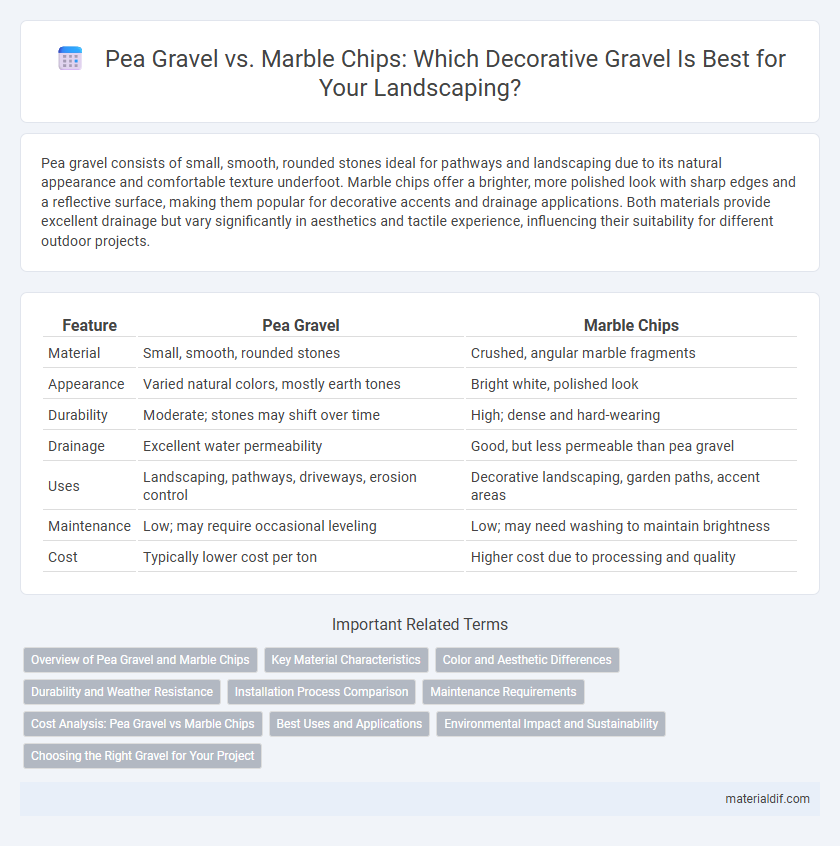Pea gravel consists of small, smooth, rounded stones ideal for pathways and landscaping due to its natural appearance and comfortable texture underfoot. Marble chips offer a brighter, more polished look with sharp edges and a reflective surface, making them popular for decorative accents and drainage applications. Both materials provide excellent drainage but vary significantly in aesthetics and tactile experience, influencing their suitability for different outdoor projects.
Table of Comparison
| Feature | Pea Gravel | Marble Chips |
|---|---|---|
| Material | Small, smooth, rounded stones | Crushed, angular marble fragments |
| Appearance | Varied natural colors, mostly earth tones | Bright white, polished look |
| Durability | Moderate; stones may shift over time | High; dense and hard-wearing |
| Drainage | Excellent water permeability | Good, but less permeable than pea gravel |
| Uses | Landscaping, pathways, driveways, erosion control | Decorative landscaping, garden paths, accent areas |
| Maintenance | Low; may require occasional leveling | Low; may need washing to maintain brightness |
| Cost | Typically lower cost per ton | Higher cost due to processing and quality |
Overview of Pea Gravel and Marble Chips
Pea gravel consists of small, rounded stones typically ranging from 3 to 10 millimeters in diameter, known for its smooth texture and natural earth tones, making it ideal for landscaping, walkways, and drainage projects. Marble chips are angular, crushed stones made from pulverized marble and offer a bright, white appearance with reflective properties, commonly used for decorative mulch, driveways, and garden paths. Both materials vary in durability and aesthetics, with pea gravel providing softness underfoot and marble chips delivering a polished, high-contrast look.
Key Material Characteristics
Pea gravel consists of small, rounded stones typically measuring 1/8 to 3/8 inches in diameter, offering smooth texture and excellent drainage properties. Marble chips are angular, irregularly shaped fragments made from crushed marble, known for their bright white color and polished appearance. Pea gravel is softer and less abrasive, making it ideal for pathways, while marble chips provide a harder surface suited for decorative landscaping and driveways.
Color and Aesthetic Differences
Pea gravel typically features smooth, rounded stones in natural earth tones like tan, brown, and gray, offering a casual, rustic appearance ideal for pathways and garden beds. Marble chips present a polished, angular look with a bright white or cream color that enhances modern and formal landscapes by providing contrast and brightness. The color and texture differences between pea gravel and marble chips significantly influence the overall aesthetic, with pea gravel blending seamlessly into natural settings while marble chips create a striking, elegant visual impact.
Durability and Weather Resistance
Pea gravel offers moderate durability and performs well in various weather conditions due to its rounded edges that resist erosion but may compact over time. Marble chips provide superior durability with a harder composition, maintaining structural integrity and resisting weathering effects such as freeze-thaw cycles and UV exposure. Choosing between pea gravel and marble chips depends on the specific environmental stresses and the desired longevity of the surface.
Installation Process Comparison
Pea gravel installation involves spreading small, rounded stones typically 1/8 to 3/8 inches in diameter over a prepared base, requiring minimal compaction and offering excellent drainage. Marble chips, larger and more angular, often range from 1/4 to 3/4 inches and need a well-compacted, leveled base to prevent shifting and ensure stability. Both materials benefit from landscape fabric underneath to inhibit weed growth, but marble chips may require additional edging or stabilization measures to maintain a clean, polished appearance.
Maintenance Requirements
Pea gravel requires minimal maintenance, primarily involving occasional raking to keep the surface even and removal of weeds that may grow through the stones. Marble chips, while visually striking, demand more frequent cleaning to prevent staining and may need replenishment as the stones break down over time. Both materials benefit from periodic washing to maintain their appearance, but pea gravel generally offers a lower-maintenance solution for landscaping projects.
Cost Analysis: Pea Gravel vs Marble Chips
Pea gravel typically costs between $30 and $60 per ton, making it a budget-friendly option for landscaping and driveways, whereas marble chips range from $75 to $150 per ton due to their premium aesthetic and density. Installation costs for pea gravel are generally lower because of their smaller size and ease of spreading, while marble chips may require additional labor for proper edging and stabilization. Maintenance expenses also favor pea gravel, as marble chips can degrade faster under heavy traffic, potentially increasing long-term costs.
Best Uses and Applications
Pea gravel is ideal for landscaping projects such as garden pathways, playground surfaces, and drainage areas due to its smooth texture and excellent water permeability. Marble chips are commonly used in decorative applications like driveways, walkways, and as mulch in flower beds, offering a polished appearance and durability. Both materials enhance aesthetics and functionality but are chosen based on specific project requirements, including surface texture and desired visual appeal.
Environmental Impact and Sustainability
Pea gravel offers a lower environmental impact due to its natural sourcing and minimal processing compared to marble chips, which require extensive quarrying and energy-intensive crushing. Marble chips, often a byproduct of marble production, can be recycled, but their extraction contributes to habitat disruption and carbon emissions. Choosing pea gravel supports sustainability with its biodegradable, non-toxic characteristics and reduced carbon footprint in landscaping projects.
Choosing the Right Gravel for Your Project
Pea gravel offers smooth, rounded stones ideal for walkways and drainage, promoting excellent water flow and comfort underfoot. Marble chips provide a sleek, polished appearance with sharper edges, enhancing aesthetics for driveways and decorative landscaping. Selecting the right gravel depends on project requirements such as drainage efficiency, surface texture, and visual appeal.
Pea Gravel vs Marble Chips Infographic

 materialdif.com
materialdif.com